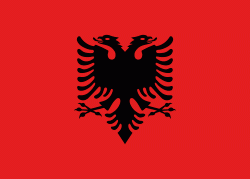University of Tirana (University of Tirana)
The University of Tirana (Universiteti i Tiranës, abbreviated UT) is a public university located at the central borough of Tirana 10 in Tirana, Albania. It was established as the State University of Tirana in 1957 through merging of five existing institutes of higher education.
The main building was planned by Italian architect, Gherardo Bosio at the beginning of 1940. It is situated at the Mother Teresa Square, south of the city center of Tirana.
The primary language of instruction is Albanian, but there are a number of faculties of foreign languages which are carried out in English, French, Greek, Italian, Spanish, German, Chinese and other languages.
The University of Tirana was founded in 1957 as the State University of Tirana (Universiteti Shtetëror i Tiranës), through the merging of five existing institutes of higher education, the most important of which was the Institute of Sciences, founded in 1947. Immediately after the death of Enver Hoxha in 1985, the university was renamed the Enver Hoxha University of Tirana (Universiteti i Tiranës Enver Hoxha) until 1992.
The university is the largest and highest ranking university in Albania. It includes eight colleges, 50 academic departments, and 41 study programs or majors. Most programs are offered in Tirana; a few smaller affiliated campuses are located in other Albanian cities, including Saranda in the southern part of the country and Kukës in the north. It offers three-year Bachelor, one- or two-year Master, and three- to five-year doctorate degree programs, in accordance with the Bologna system.
The current campus is urban and decentralised. A new large and centralised campus has been planned in the southeast periphery of Tirana. Students dorms are grouped in a separate location called Student City (Qyteti Studenti) in southeast Tirana.
UT is the biggest university in Albania, and among the biggest in Europe with 35 000 students. In 2013 the college accepted 95 new Ph.D. students. These are students in possession of bachelor's degrees.
The main building was planned by Italian architect, Gherardo Bosio at the beginning of 1940. It is situated at the Mother Teresa Square, south of the city center of Tirana.
The primary language of instruction is Albanian, but there are a number of faculties of foreign languages which are carried out in English, French, Greek, Italian, Spanish, German, Chinese and other languages.
The University of Tirana was founded in 1957 as the State University of Tirana (Universiteti Shtetëror i Tiranës), through the merging of five existing institutes of higher education, the most important of which was the Institute of Sciences, founded in 1947. Immediately after the death of Enver Hoxha in 1985, the university was renamed the Enver Hoxha University of Tirana (Universiteti i Tiranës Enver Hoxha) until 1992.
The university is the largest and highest ranking university in Albania. It includes eight colleges, 50 academic departments, and 41 study programs or majors. Most programs are offered in Tirana; a few smaller affiliated campuses are located in other Albanian cities, including Saranda in the southern part of the country and Kukës in the north. It offers three-year Bachelor, one- or two-year Master, and three- to five-year doctorate degree programs, in accordance with the Bologna system.
The current campus is urban and decentralised. A new large and centralised campus has been planned in the southeast periphery of Tirana. Students dorms are grouped in a separate location called Student City (Qyteti Studenti) in southeast Tirana.
UT is the biggest university in Albania, and among the biggest in Europe with 35 000 students. In 2013 the college accepted 95 new Ph.D. students. These are students in possession of bachelor's degrees.
Map - University of Tirana (University of Tirana)
Map
Country - Albania
 |
 |
| Flag of Albania | |
Albania has been inhabited by different civilisations over time, such as the Illyrians, Thracians, Ancient Greeks, Romans, Byzantines, Venetians, and Ottomans. The Albanians established the autonomous Principality of Arbër in the 12th century. The Kingdom of Albania and Principality of Albania formed between the 13th and 14th centuries. Prior to the Ottoman conquest of Albania in the 15th century, the Albanian resistance to Ottoman expansion into Europe led by Skanderbeg won them acclaim over most of Europe. Albania remained under Ottoman rule for nearly five centuries, during which many Albanians (known as Arnauts) attained high-ranking offices in the empire, especially in the Southern Balkans and Egypt. Between the 18th and 19th centuries, cultural developments, widely attributed to Albanians having gathered both spiritual and intellectual strength, conclusively led to the Albanian Renaissance. After the defeat of the Ottomans in the Balkan Wars, the modern nation state of Albania declared independence in 1912. In the 20th century, the Kingdom of Albania was invaded by Italy, which formed Greater Albania before becoming a protectorate of Nazi Germany. Enver Hoxha formed the People's Socialist Republic of Albania after World War II, modeled under the terms of Hoxhaism. The Revolutions of 1991 concluded the fall of communism in Albania and eventually the establishment of the current Republic of Albania.
Currency / Language
| ISO | Currency | Symbol | Significant figures |
|---|---|---|---|
| ALL | Albanian lek | L | 2 |
| ISO | Language |
|---|---|
| SQ | Albanian language |
| EL | Greek language |















